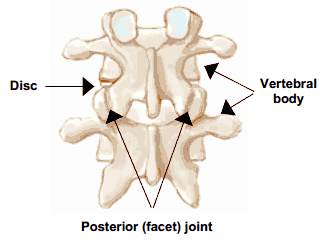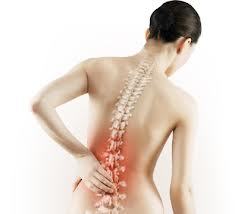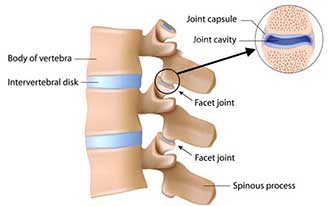Facet Disease and Facet Syndrome
What is it?
Facet joints (a.k.a. Zygopophyseal joints) are located on the back (posterior) part of the spine and their alignment allow for movement, such as bending forward or backwards and twisting of the neck and upper back. There are two facet joints between each pair of vertebrae, one on each side of the spine.
Facet joints are similar in structure to a knee joint in that they are made up of bone and cartilage, surrounded by a joint capsule and filled with joint fluid (synovial fluid). Each facet joint is made up of bone between two adjacent vertebrae, so that a bony knob from the vertebra above, the superior articular process, joins with a bony knob from the vertebra below, the inferior articular process of the vertebra below to form the facet joint. Each of the bony knobs are lined with cartilage, a rubbery material that allows smooth movement.
Most of the time, these facet joints move with no problem, and many people don’t even realize that the joints exist. It is when the capsule surrounding the joint or the protective cartilage breaks down that most people feel neck pain or back pain, and that pain usually occurs with movement, especially bending sideways or backwards.
Bending forward takes pressure off the facet joints, so people suffering from back pain or neck pain in the facet joint, usually feel better when they are in this forward flexed position.
Who Gets It?
Although trauma, such as whiplash or motor vehicle accidents can cause pain in the facet joints, it is much more likely to result from some form of arthritis. Osteoarthritis is the most common form of facet joint arthritis and results from degenerative changes of the disc and wear and tear on a joint.
As a disc thins with aging and from daily wear and tear, the space between two spinal vertebra shrinks, causing the facet joints to press together and leading to the erosion of the cartilage and enlargement of the facet joints and pain.
Usually, facet joint pain occurs in those with older age; however, those who perform strenuous activities, such as contact sports or heavy labor, can wear down their discs and facet joints prematurely. The most common facet joints involved in osteoarthritis are the lowest facet joints of the lower back (causing lower back pain) and also the facet joints of the neck (causing neck pain.)
On the other hand, rheumatoid arthritis, though much less common than osteoarthritis, is another cause of facet joint pain. Rheumatoid arthritis results in the breakdown of the joint structures due to an overactive immune system. The body will recognize the joint capsules as foreign and destroy them, causing pain.
Usually, this condition presents in other joints first – hands, feet, and knees – but it can certainly progress to the facet joints, usually of the neck rather than the lower back. In this case, treating the condition with immunosuppressant drugs may be necessary.

What Kind Of Pain Results?
Several types of back pain or neck pain are common with facet joint deterioration. Often, the muscles surrounding the joint will spasm, and this can cause muscular pain that grabs with every movement of the back. You may also experience tenderness when the skin over the area is probed by fingers or from lying flat on the back. Many patients find that they cannot move through their normal range of motion due to the pain inhibiting their ability to move. Although disc herniation is more likely to cause radiating nerve pain, some facet joint problems can cause pain that mimics this condition.
Facet joint problems of the lower back can lead to lower back pain that descends into the buttocks and back of the legs. Unlike disc herniation, though, the pain does not present in the front of the leg or go much beyond the knee. Similarly, cervical facet joint syndrome can cause pain in the chest, shoulder, and upper arm as well as neck pain, but it does not travel as far as the fingers. Complicating matters, advanced facet joint arthritis can enlarge the facet joints, making the holes for exiting spinal nerves smaller, resulting in irritation of a spinal nerve and pain that travels to the ends of the extremities.

Treatment
Complete Pain Care can help you significantly with facet joint pain, neck pain and lower back pain. Medial nerve injections are nerve blocks at the nerve that sends signals from a specific facet joint. In fact, this procedure is often used to diagnose this condition, because if you experience pain relief from the block, it is likely a facet problem. Similarly, radio frequency lesioning (Rhizotomy) is a controlled method of heating the nerves that supply the facet joints so that the pain signal from the facet joint is stopped. Although the facet joints are still arthritic, the pain is much less. The pain relieving effect of this procedure is approximately 6-8 months. The nerves do regenerate after that time, but the procedures can be repeated indefinitely and are well tolerated by patients.
If pain is traveling down the an extremity (like lower back pain causing sciatica) due to narrowing of the hole for the spinal nerve from an enlarged facet joint, an epidural steroid injection is the best treatment. If back pain persists even though the radiating pains are improved, then medial branch blocks would be an appropriate treatment. If the pain is not satisfactorily relieved by the injections or injections are not done, another treatment choice is medications. A combination of anti-inflammatory medications, anti-seizure medications, and antidepressants can help control the various causes of facet joint pain.

Other Providers On The Team
Physical therapy is an important adjunct to any pain management treatment as it helps to ease muscle spasm, promote flexibility, and reduce pain. If it is not tolerated prior to injections, then it should be done after the injections are done and the pain is better to promote better function of the back. Osteopathic physicians and Chiropractors may help with alignment of the spine and facet joints. Rheumatologists: If you have diffuse rheumatoid arthritis, a rheumatologist will likely start you on for immunosuppressant therapy. Spine Surgeon: if all the above does not help your pain, then major spinal fusion surgery may help reduce severe pain at the expense of mobility.


